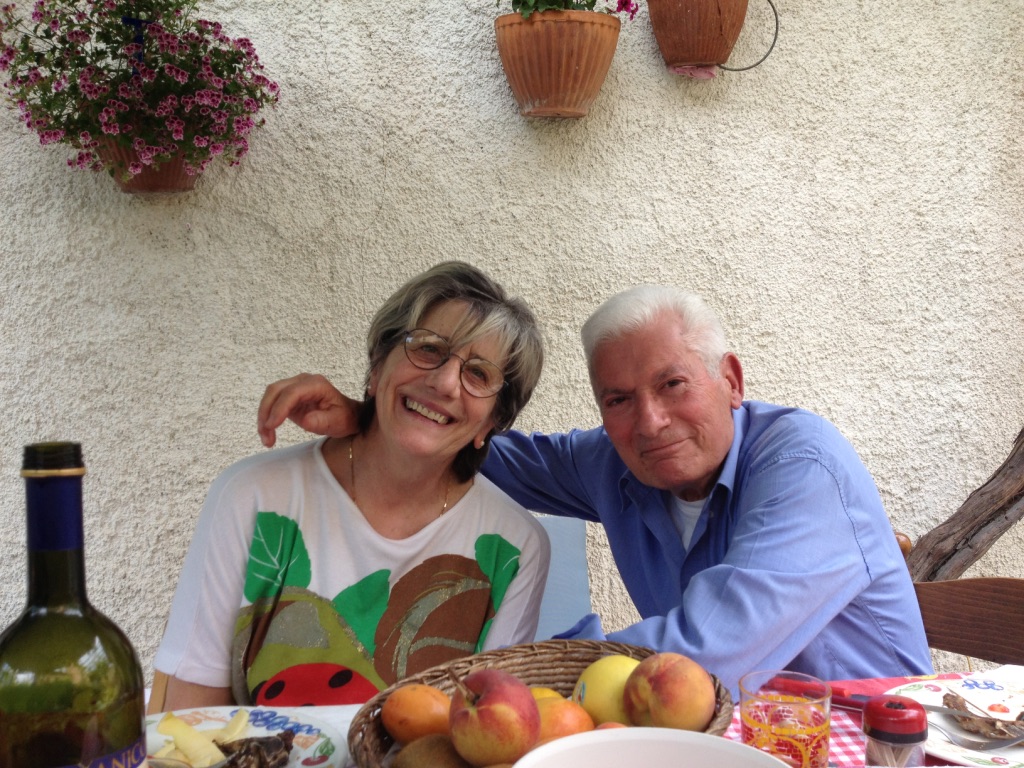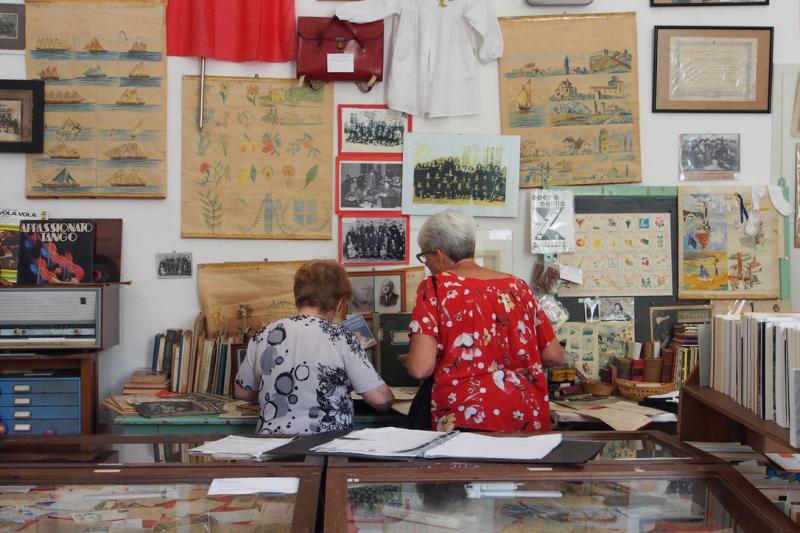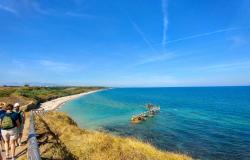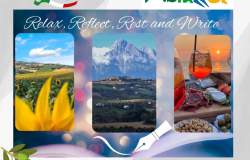This month’s installment in our series on readers traveling to Italy in search of their roots and relatives features the story of Mary Louise Tucker, who has been drawn to her family history since she was young, hearing stories from her nonno about life in Abruzzo before he emigrated to Philadelphia as a 14-year-old boy. Mary Louise herself is an emigrant, having moved from the U.S. to Australia as a young woman.
Mary Louise has traveled to Italy many times to put the pieces of her family history together; and she keeps on searching - for more relatives and for more stories. Her maternal grandparents were from different villages, about 15 kilometers apart, in the province of Teramo, Abruzzo. That has brought her to several villages in the region. She points out how getting better at speaking Italian is essential for communication with Italian relatives of the older generation.
Mary Louise also shares with us some great tips on what and how to search, both online and onsite in Italy.
Mary Louise, what prompted you to begin your search to trace your Italian roots?
Not long after our maternal grandmother, Anna Mezzacappa died in 1970, our grandfather Giovanni (John) Pergolini, sold up in Philadelphia and moved to the seaside in New Jersey. When I visited Pop-Pop (we never called him Nonno), we would take strolls on the boardwalk and he would reminisce, in broken English, about his youth on the Adriatic coast of Italy. He showed me photos and postcards that family in Abruzzo had sent going back to 1909 when he emigrated. He recalled the poor living and working conditions in his village, leaving school after three years to learn the tailoring trade at the age of nine, his family life and the torturous ship journey to Philadelphia, alone, and only 14 years old.
All of this made me curious about my grandparents’ origins. However, I spoke neither their dialect nor proper Italian at that time. And I had a few years of study ahead of me before I could travel to Italy.
Please describe the process. Did you already know your ancestral town?
I was always curious and had learned that my mother’s parents both came from the Teramo province of Abruzzo; Anna Mezzacappa (b. 1904) from the medieval town of Morro d’Oro, about a 15-minute drive from the Adriatic coast, and John (b. 1895 as Giovanni) Pergolini from the coastal settlement, then known as ‘Rosburgo’, and now Roseto degli Abruzzi (called ‘Roseto’). My grandparents had gone back to visit once, in 1963. This was all I knew before going to Italy in 1979.
I had known living relatives in Italy of my grandfather at the start my search. Although initially I spoke no Italian, I had the contact details for my 69-year-old great uncle, Zio Vittorio, in Rome.
It was December 1979 when I arrived at Termini railway station. I recall asking a young Italian woman, a university student who spoke some English, to phone Zio for me (using a pay phone and a gettone – a phone token) to find directions to his apartment.
Fortunately, Zio’s wife, Zia Tina, spoke excellent French, and so, with my schoolgirl French and some Spanish (plus gestures and charades), we managed to communicate.
Zio recalled the story of Rosburgo. Its history began in the medieval town of Montepagano, which overlooks the Adriatic Sea. For hundreds of years, Montepagano was the seat of the ‘Comune’, the administrative centre for the area and where all births, deaths and marriages were registered. But with the growing popularity of the railway built along the coast, many people, including my grandfather’s Pergolini family, had moved down the hillside to the narrow coastal strip near the railway station to a settlement then called ‘Rosburgo’. In 1927, the settlement had grown to a town and was renamed Roseto degli Abruzzi. Since then, it has been the location of the Comune, replacing Montepagano, and is now the charming and quiet ‘frazione’ of ‘Roseto’.

What was your first resource when you started your search for your ancestral town and Italian relatives?
I had known living relatives, as mentioned, for my grandfather’s family.
In my grandmother’s case, I knew only her parents’ names, Nicola Mezzacappa and Antonietta DiRocco, and her mother’s place of birth, Morro d’Oro.
I had a Philadelphia Death Certificate for Nicola, which I found on Ancestry.com. Fortunately, it mentioned his parents’ names. It helps if the American death certificate gives the mother’s maiden name. The search on my grandmother’s Mezzacappa family continues.
For immigration records, I searched online for arrivals in New York (Ellis Island or Family Search are useful) and Philadelphia (Family Search) as these generally say where the arriving person is from and who they left behind.
The hints on the various ancestry and heritage sites are not always correct. I make my research a part of every visit, to try to back up my research with a paper trail. However, it requires much scouring of the records available, speaking to relatives and members of the community, and dragging my husband through cemeteries.
Don’t overlook the resources of small private museums that curators may open on request.
What were the obstacles, if any, during the process of finding your relatives and then getting in touch?
Initially, the biggest obstacle was my lack of Italian. After a few years of study, I was confident enough to visit the Comune.
Some provinces in the smaller regions don’t yet have their birth, death and marriage registers digitized, so it’s a long process to wade through hundreds of pages of images on sites such as Antenati and Ancestry.com. And although some digitized records make text searches available, beware of transcription errors. Try alternative spellings and view the images.
If you go it alone, make an appointment well in advance to visit the Comune to search for records and know an exact date or a range of dates for births, deaths and marriages.
Prepare to wade through pages of cursive script or have a local with you who is more adept at reading it and translating some words. My cousin, a former librarian, said some Comuni used to list all of the local peasants by name along with their possessions, including shovels, carts, donkeys, pigs, etc. in large volumes. I have yet to view one.
Most Comuni will not allow you to photograph the birth, death and marriage registers. Some will photocopy pages for you at a cost. Take a notepad, be patient and thank the person who allows you access.

Please describe the moment when you first met your Italian relatives. How did you feel?
In 1979, I met my first relatives who lived in Rome. Zio Vittorio and other family in Rome were incredibly welcoming. Zio was tearful when I arrived and wanted news of his siblings; although they had always stayed in touch by letter and photo, to have a living relative in his home was a joy. With the benefit of hindsight, I see now that I was an immature 23-year-old with little sense of how Zio must have felt.
One young cousin in Rome, who spoke some English, was a great translator who helped me navigate public transportation. I was overwhelmed at how they invited me to know ‘their’ Rome, their ‘vita quotidiana’ – everyday life – the Mercato at Trionfale, the local espresso bars and pastry shops, as well as the famous sights.
In 1985, I went to the Abruzzo region for the first time. In Roseto I found my mother’s cousin Argia’s house. When I knocked on the kitchen door I was greeted by a tiny, bright-eyed woman with greying hair pulled back in a knot, and a kitchen apron over her dress. Argia looked up at me and burst into tears saying “La figlia di Luisa” – “Louise’s daughter”.
Argia sat me at the kitchen table while she fussed about. Before I knew it, the familiar aroma of coffee on the stovetop filled the room and brought on a pang of nostalgia for my grandparent’s kitchen. I drank tiny cups of sweetened black coffee and some small biscuits called cantucci, like biscotti but harder, smaller and containing as much almond meal as flour – perfect for dunking.
While we chatted, Argia’s son Walter arrived. He spoke very clear Italian, but no English. As we embraced, he said Zio in Roma had phoned the evening before and had alerted them that I may turn up.
Please describe how you felt the first time you walked the streets of your ancestral town.
On first meeting family in Roseto we spent hours relating stories about the family. My Italian vocabulary was still limited so we gave my dictionary a workout.
Walter and family showed me the house where the Pergolini siblings had lived. We visited ancient Montepagano where I saw old stone houses, the remains of the city gates, narrow streets and panoramic views of the Adriatic Sea in one direction and the highest peaks of the Apennine mountains in the other. Peering into open windows and doorways I got a sense of what life must have been like for my ancestors.
I visited my great grandparents’ graves on the hillside with a view of their beloved Adriatic and wept for my grandfather who had crossed the Atlantic alone as a mere 14-year-old.
Any fun anecdotes about meeting your Italian relatives?
My grandfather, a master tailor, had a strong Italian accent and spoke in fun and ingenious ways. He never called a car an automobile. It was always ‘the machine’ from the Italian ‘la macchina’. He encouraged us to sew properly and not take short cuts. He advised us to buy good quality fabrics because the ‘niza stuffa’ (‘nice stuff’), would last longer.
One year my sister Annie and I met in Italy. While having lunch with our cousin Walter and his wife Adriana, Annie and I were speaking to one another in English. We were trying to find the correct word for ‘fabric’. Fabbrica? No. Tessile? No. Tessuto? Si! Then Walter piped up “Stoffa”. Well, my sister nearly split a gut laughing. I just blurted out in a cheesy Italian accent “datsa niza stuffa”! Our cousins looked at us like we were “un po’ pazze”, slightly crazy. My sister left it to me to try to explain how we had probably been hearing Italian as kids but had not even realized it. How stupid did we feel?! What else had we missed? We all laughed it off and enjoyed another glass of wine.

Did you discover any amazing story during the process of searching for your Italian relatives?
Once, while visiting Roseto with my husband and sister, we chatted with some older men who knew our Zio and other Pergolini family. One man went home to find a shoebox of old photos, including some of the shoemaker’s shop that had belonged to our great uncle, Zio Guido. They told us that that when the fascist soldiers came to town in the 1930s everyone was encouraged to fly the fascist flag. Guido was opposed to the regime and refused. Effectively, he was blacklisted. He moved with his young family to Rome where one could live and work more anonymously. Zio Guido remained in Rome until his death and most of his descendants continue to live there. The old men in the piazza told us there were countless stories of people who left because of fascism, poverty and war.
Ultimately, what has the experience of reconnecting to your Italian roots meant to you?
My search for family motivated me to learn ‘la bella lingua’, and surely improved my appreciation of art, history and the many cuisines of Italy. Abruzzo has always been at the heart of my Italian family around the world, but now I have a whole peninsula to explore.
Learning what generations before us have endured and overcome, I feel a great sense of both sadness and pride. I now see generations of my family in a new light. Their bravery and courage have paved the way for us to not only survive but thrive.
No one takes the decision to emigrate lightly. I left America and emigrated to Australia as a young woman and I now see a new generation of people from all over the world trying to better their lives, as our grandparents did. Discovering my ancestors’ voyages has opened my mind to what humanity has in common, not our differences.
Thank you, Mary Louise, for sharing your beautiful story and your insights with Italy Magazine readers.









